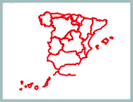Information on the Spanish autonomous system, its legal regime and the relations of the General Administration of the State with the Autonomous Communities.
Autonomic policy

Starting from the declaration of Article 2 of the Spanish Constitution, which recognizes and guarantees the right to autonomy of the nationalities and regions that make up Spain, Title VIII of the Constitution establishes the territorial organization of Spain, which consists of three levels: the State or central organization, the Autonomous Communities and the Local Entities.
Although in a strict sense, the constitution of the Autonomous Communities was made effective from the voluntary aspect and from the beginning, since the Constitution does not configure the political map of the country, the result is that since 1983 the entire Spanish territory is organized in 17 Autonomous Communities, an organization that was completed in 1995 with the approval of the Statutes of Autonomy for the Cities of Ceuta and Melilla.
The basic institutional norm of each Autonomous Community is its Statute, in which both its own institutional framework and the system of attribution of competences are configured and developed, and this within the limits established by articles 148 and 149 of the Constitution.
In short, there are four types of subjects on which so many other forms of exercise of competence fall: those that correspond exclusively to the State; those in which the State legislates and the Autonomous Communities implement this legislation; a third type, in which the State approves the basic legislation, while its legislative development and execution correspond to the Autonomous Communities; and the exclusive competences of the Communities.
The complexity of the system and the difficulties in clarifying it in ordinary administrative activity has led to frequent conflict, which has been resolved through the jurisprudence issued by the Constitutional Court. Through this system of conflict resolution, this body has played a very important role in the interpretation of the competences that correspond to the State and the Autonomous Communities.
The autonomous system has become effective through the transfer of services and means available to the State to the Autonomous Communities, a gradual process that has involved the change of secondment of more than 820,000 public employees who have become dependent on the Autonomous Communities. Based on these initial means, the Autonomous Communities have equipped themselves with the necessary personnel to provide and provide the services that correspond to them, including health care, education and social services.
But the relations between the state and autonomous powers are not only raised in terms of possible conflict, but also in terms of cooperation. The interlinking of competences, the shared nature of many of the material competences and the need to articulate joint policies to be developed throughout the territory have promoted the creation of different instruments of cooperation that make possible the coherent and efficient functioning of the autonomous system. This system has been gradually developed and consolidated, taking into account the practice and experience. Formally it can take two forms or possibilities: multilateral or sectoral cooperation, in which the State and all the Autonomous Communities participate jointly; and bilateral cooperation, in which the State and a single Autonomous Community participate. The Conference of Presidents and the Sectoral Conferences have a central role in this system.
The autonomous system of cooperation has a special organization to attend to the issues arising from the process of community integration. The successive reforms of the Community treaties have meant an increase in the competences of the European Union, which affects the internal system of competences. To meet this new need, a system of autonomous participation has been articulated in cases where the Community proposal fits into the competences or affects the interests of the Autonomous Communities. In the same way, the generalization of regional foreign activity has made it necessary to devise coordination instruments to ensure that this activity is consistent and fits into the competencies that in international relations belong exclusively to the State.
Finally, the services provided by the Autonomous Communities require financial resources that are periodically reviewed and that have been made effective through the successive Agreements on the financing model, the one agreed in 2008 being currently in force. The successive systems have entailed different modifications and adaptations to a changing reality and have been approved as the Autonomous Communities had new responsibilities and had to attend to new public services.